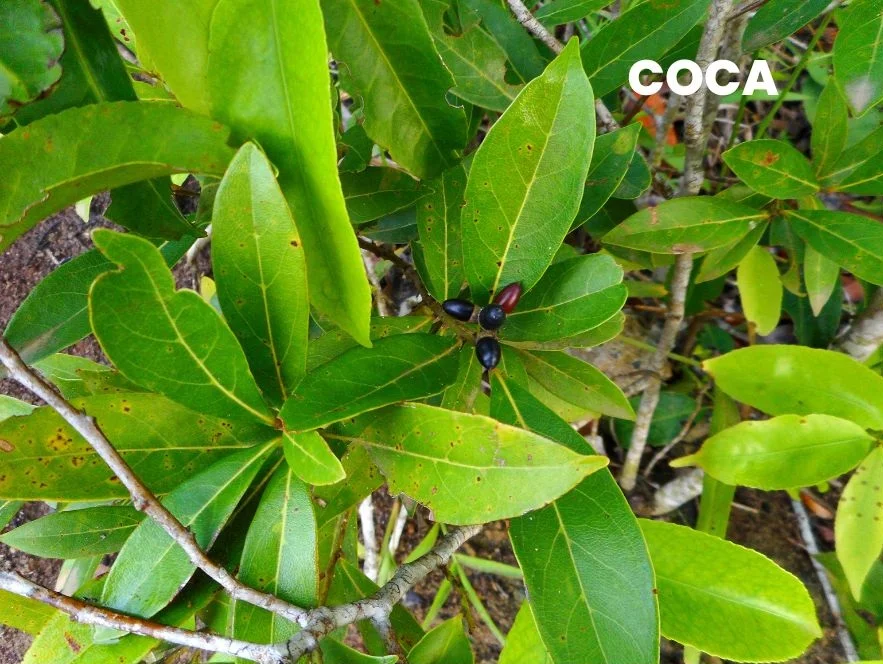Coca, scientifically known as Erythroxylon coca, is often referred to as the “Divine Plant of the Incas.”
This remarkable plant has been utilized for centuries by indigenous cultures in the Andes mountains for its medicinal and stimulating properties.
Despite its beneficial uses, it has faced significant scrutiny and condemnation, particularly from Spanish priests, who labeled it as “un delusion del demonio” due to its psychoactive effects.
In homeopathy, Coca is primarily employed to address a range of ailments associated with mountain climbing, nervous exhaustion, and respiratory issues.

Table of Contents
ToggleSOURCE INFORMATION
Scientific Classification
- Kingdom: Plantae
- Clade: Angiosperms
- Clade: Eudicots, Rosids
- Order: Malpighiales
- Family: Erythroxylaceae
- Genus: Erythroxylon
- Species: E. coca
Origin
- Erythroxylon coca is native to the Andean region of South America, particularly in Bolivia, Peru, and Colombia.
- The indigenous peoples of these regions have cultivated coca plants for thousands of years, using the leaves to combat altitude sickness, fatigue, and hunger.
Historical Facts
- The coca plant has a rich history dating back to pre-Columbian times, where it was revered by the Incas as a sacred plant.
- They used coca leaves for their stimulating effects, particularly in the high-altitude regions where they lived.
- Coca has also played a significant role in traditional medicine, ritualistic practices, and social customs.
- Its association with the extraction of cocaine in the 19th century led to a complex relationship with the plant, as it became both a medicinal agent and a subject of controversy due to its psychoactive components.
DRUG PATHOGENESIS
- Coca is known to stimulate the central nervous system, helping to alleviate fatigue, improve mental clarity, and enhance physical endurance.
- It is beneficial for conditions arising from physical exertion, altitude sickness, and exhaustion.
- The remedy can also aid in respiratory conditions by improving lung function and reducing symptoms like dyspnea and hoarseness.
PHYSICAL CONSTITUTION
- Individuals requiring Coca often exhibit signs of nervous exhaustion and may have a frail physical constitution, particularly when experiencing fatigue due to high altitudes or mental strain.
- They may be sensitive to their surroundings, leading to anxiety and restlessness.
WHAT IS CONSTITUTION IN HOMOEOPATHY?
DIATHESIS
- Coca is typically indicated for individuals with a nervous or melancholic diathesis, often characterized by fatigue, anxiety, and depressive symptoms.
- Patients may experience physical symptoms that correlate with their emotional state.
WHAT IS DIATHESIS IN HOMOEOPATHY?
TEMPERAMENTS
- The ideal patient for Coca may present with a combination of nervousness, irritability, and a tendency to isolate themselves socially.
- They might prefer solitude and feel uncomfortable in social settings.
WHAT ARE TEMPERAMENTS IN HOMOEOPATHY?
KEY CHARACTERISTICS
- Mind: Melancholic, bashful, socially anxious, irritable.
- Head: Symptoms related to altitude, including headaches and vertigo.
- Heart: Palpitations and weak heart with dyspnea.
- Respiratory: Conditions like asthma and hoarseness, especially after talking.
PSYCHOLOGICAL BACKGROUND

Melancholy and Depression
- Individuals who benefit from Coca may experience feelings of melancholy—a deep, enduring sadness that can be associated with mental and physical exhaustion.
- These individuals may feel a profound sense of isolation or withdrawal from social interactions, often finding themselves bashful or socially anxious.
Irritability
- The psychological profile of Coca also includes a tendency towards irritability.
- People who respond well to this remedy may become short-tempered or easily frustrated, particularly when they feel overwhelmed by external stimuli or social pressure.
Desire for Solitude
- One of the key psychological traits of a person requiring Coca is the strong inclination to isolate themselves from society.
- They may actively avoid social gatherings, feeling more comfortable in solitude or obscurity.
- This avoidance could stem from an inherent sense of inadequacy or self-consciousness, making social situations emotionally draining.
Sense of Right and Wrong Abolished
- The individual may experience a blunted moral compass or an inability to discern the difference between right and wrong.
- This could manifest as a form of emotional disconnection or detachment from their own values, perhaps due to a sense of fatigue or inner conflict.
- In extreme cases, this may result in actions or decisions that defy their usual sense of morality or ethics.
Fatigue and Nervousness
- On a psychological level, Coca addresses mental exhaustion, particularly in individuals who are overworked, overstimulated, or anxious.
- The individual may feel mentally weary, unable to focus, and plagued by thoughts that lead to a sense of nervousness or unease.
- These symptoms may also be accompanied by physical restlessness.
Heightened Sensitivity
- People needing Coca may become hypersensitive to their surroundings, with an increased perception of stimuli such as noise, light, or social interactions, which could further exacerbate their desire to withdraw from the external world.
- This sensitivity is often coupled with a sense of being overwhelmed by ordinary life circumstances.
Delirium and Hallucinations
- In extreme cases, the use of Coca or its homeopathic counterpart could be linked to hallucinations or delirium, where the individual sees or hears things that aren’t there.
- This is often a sign of deeper psychological distress and is more commonly associated with high-dose cocaine intoxication, but in homeopathic treatment, such symptoms may point to deeper psychological imbalances that the remedy seeks to address.
Psychological Themes in Coca
The psychological profile of Coca revolves around themes of:
- Withdrawal and isolation
- Mental exhaustion and melancholy
- Heightened irritability
- Abolished moral clarity and emotional disconnection
- Fatigue-induced sensitivity and overwhelm
Use in Homeopathy
Coca in homeopathic treatment is often used to address these mental states, particularly in individuals who are mentally overworked or overstimulated.
It is also helpful in conditions like nervous exhaustion, depression, and social anxiety, particularly when accompanied by a strong desire for isolation.
DETAILED ORGAN SYMPTOMS
HEAD
- Fainting Fits: Patients may experience fainting episodes during strenuous activities, particularly in mountainous terrain.
- Vertigo: Shock-like sensations emanating from the occiput, often accompanied by dizziness and a band-like headache across the forehead.
- Tinnitus and Diplopia: Noises in the ears and double vision may occur, indicating significant nervous system involvement.
STOMACH
- Peppery Sensation: Patients may describe a burning sensation in the mouth, often accompanied by a craving for alcohol and tobacco.
- Tympanitic Distention: Excessive gas and bloating in the abdomen, with a strong desire for sweets but no appetite for other foods.
HEART
- Palpitations: Rapid heartbeat, especially under physical or emotional stress, with accompanying feelings of breathlessness.
MALE GENITO-URINARY SYMPTOMS
- Diabetes with Impotency: Coca may be indicated for men suffering from diabetes that leads to sexual dysfunction.
RESPIRATORY SYMPTOMS
- Weak Vocal Cords: Patients may have difficulty speaking, with hoarseness that worsens after prolonged talking.
- Haemoptysis: Coughing up blood may occur, particularly in cases of respiratory distress.
- Spasmodic Asthma: Shortness of breath, especially in older athletes or those with a history of alcohol use.
SLEEP
- Restlessness: The inability to find comfortable rest due to nervousness and anxiety, often exacerbated during teething in children.
MODALITIES
- Better: Symptoms improve with quick motion, riding, and exposure to wine.
- Worse: Symptoms worsen with high altitudes and during ascent, leading to increased anxiety and physical discomfort.
WHAT ARE MODALITIES IN HOMOEOPATHY?
RELATIONSHIP WITH OTHER DRUGS
- Comparative Remedies: Arsenicum album (for anxiety and respiratory distress), Paulinia cupana (for energy), Cypreus (for respiratory conditions).
- Antidote: Gelsemium (for nervous disorders).
DOSE
- Coca can be administered as a tincture or in potencies up to the third attenuation, depending on the severity of symptoms and individual patient needs.
Frequently Asked Questions
What conditions can Coca treat?
- Coca is effective for symptoms associated with altitude sickness, nervous exhaustion, respiratory issues, and conditions related to stress and anxiety.
How should Coca be taken?
- Coca can be taken in tincture form or as homeopathic potencies, as directed by a healthcare provider.
Who should avoid using Coca?
- Individuals with known allergies to the coca plant or those on certain medications should consult a healthcare provider before use.
How quickly can I expect results from Coca?
- The onset of relief can vary; some may notice improvements shortly after taking the remedy, while others may require a longer duration of treatment.
Glossary of Difficult Words
- Dyspnea: Difficulty breathing or shortness of breath.
- Caries: Decay of teeth or dental cavities.
- Palpitation: Irregular or rapid heartbeat.
- Haemoptysis: Coughing up blood.
- Tympanitic: Relating to or exhibiting excessive gas in the abdomen.
- Melancholy: A deep, persistent sadness or gloom.
This comprehensive overview of Erythroxylon coca outlines its medicinal uses, historical significance, and various applications in treating specific health conditions.
As with any remedy, it is crucial to consult a qualified healthcare professional before initiating treatment.
